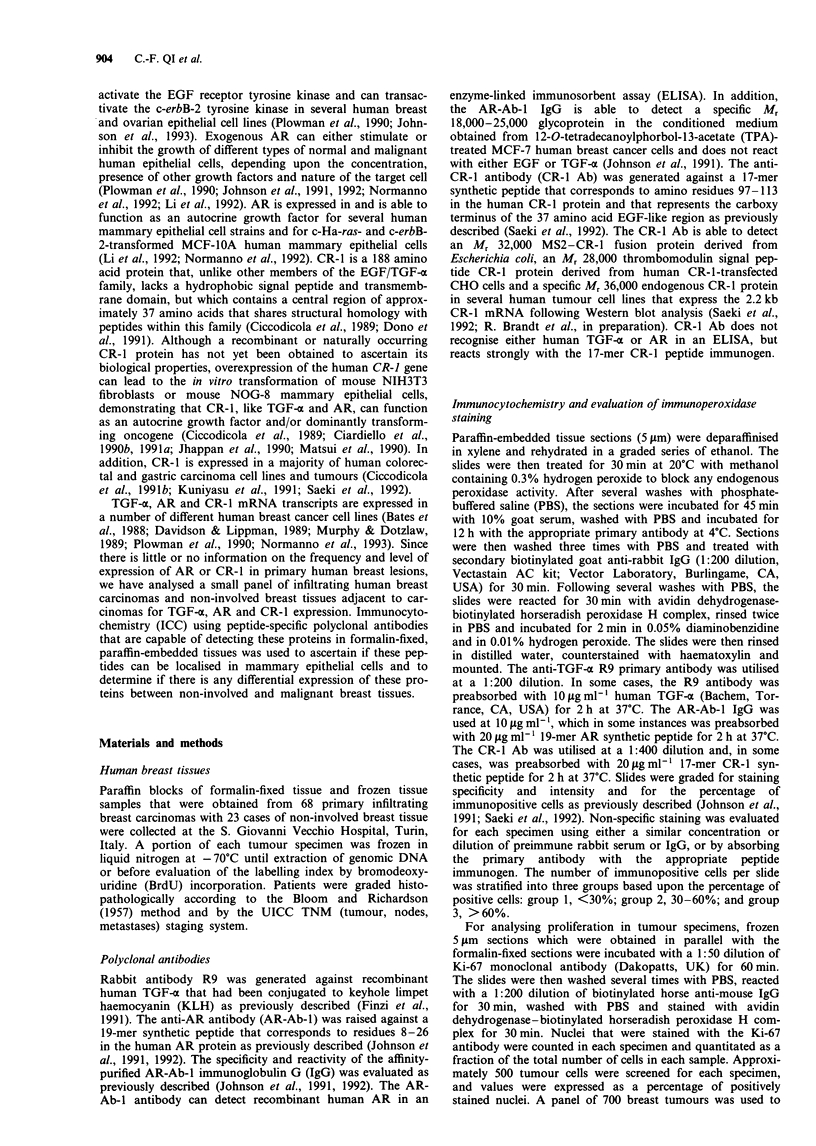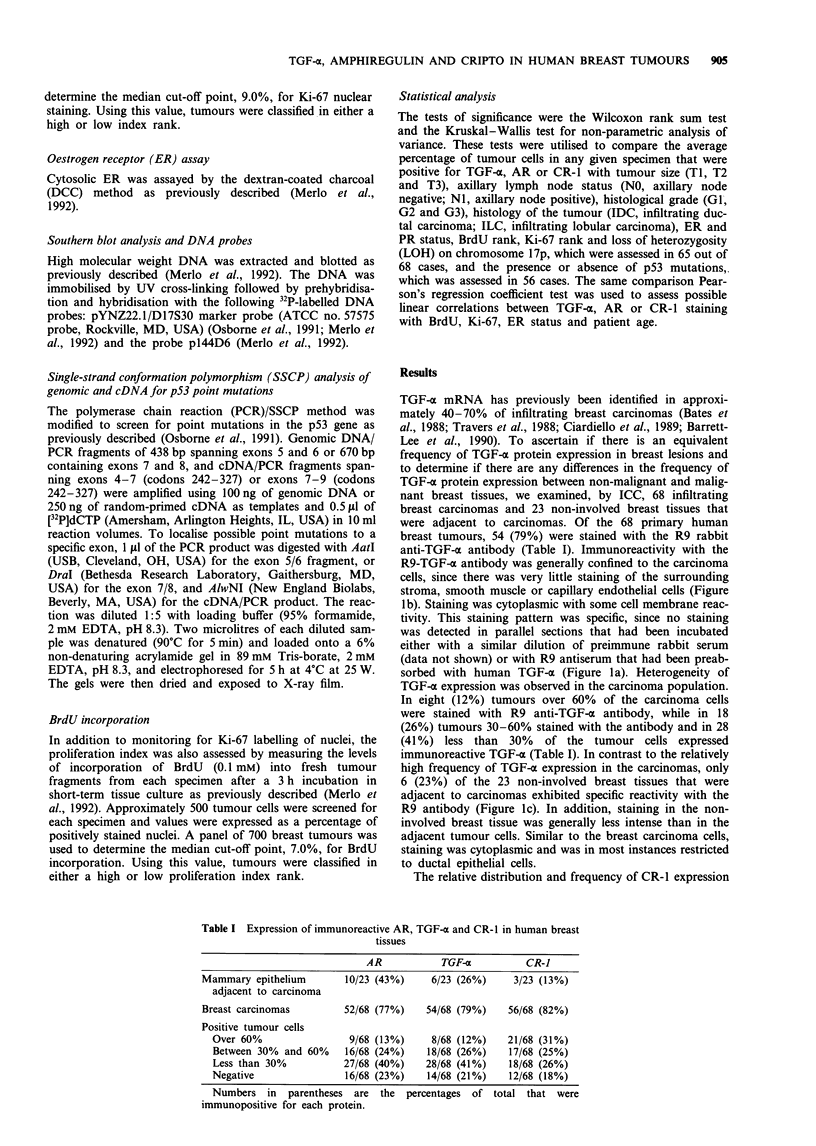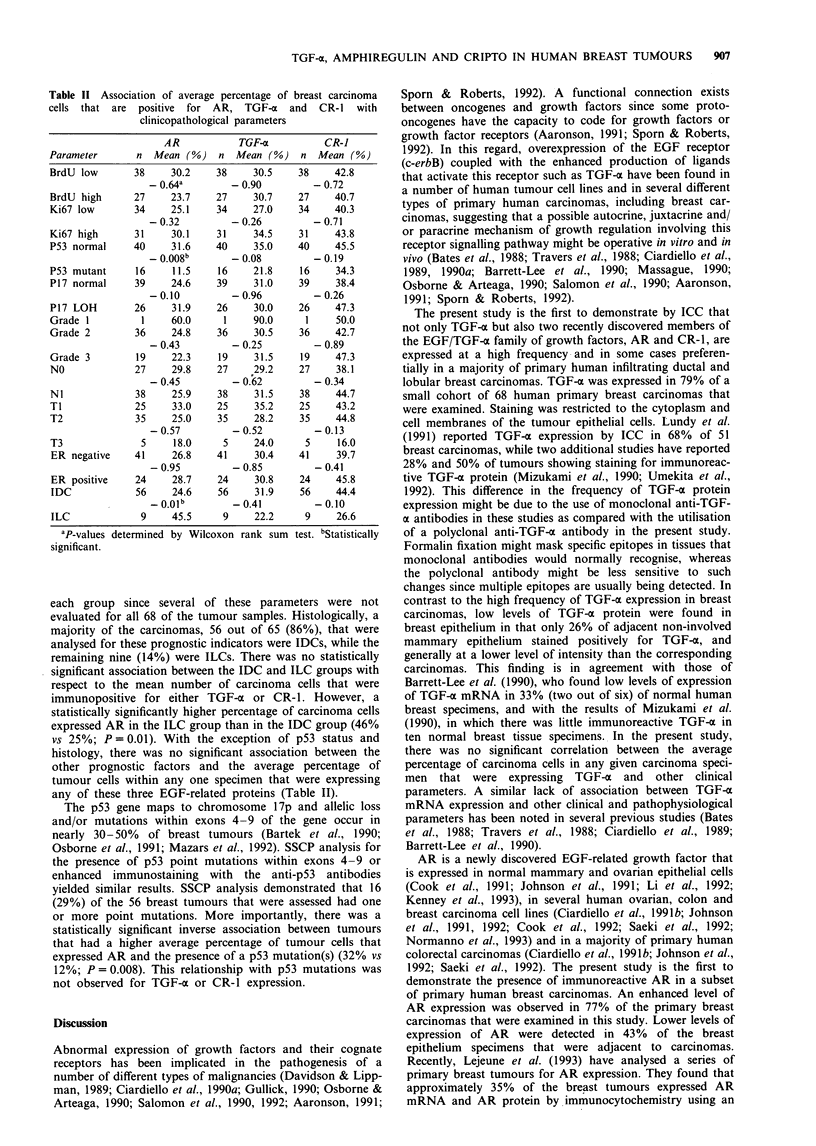Abstract
The expression of three epidermal growth factor (EGF)-related peptides, transforming growth factor alpha (TGF-alpha), amphiregulin (AR) and cripto-1 (CR-1), was examined by immunocytochemistry (ICC) in 68 primary infiltrating ductal (IDCs) and infiltrating lobular breast carcinomas (ILCs), and in 23 adjacent non-involved human mammary tissue samples. Within the 68 IDC and ILC specimens, 54 (79%) expressed immunoreactive TGF-alpha, 52 (77%) expressed AR and 56 (82%) expressed CR-1. Cytoplasmic staining was observed with all of the antibodies, and this staining could be eliminated by preabsorption of the antibodies with the appropriate peptide immunogen. Cytoplasmic staining with all of the antibodies was confined to the carcinoma cells, since no specific immunoreactivity could be detected in the surrounding stromal or endothelial cells. In addition to cytoplasmic reactivity, the AR antibody also exhibited nuclear staining in a number of the carcinoma specimens. No significant correlations were found between the percentage of carcinoma cells that were positive for TGF-alpha, AR or CR-1 and oestrogen receptor status, axillary lymph node involvement, histological grade, tumour size, proliferative index, loss of heterozygosity on chromosome 17p or overall patient survival. However, a highly significant inverse correlation was observed between the average percentage of carcinoma cells that expressed AR in individual tumours and the presence of a point-mutated p53 gene. Likewise, a significantly higher percentage of tumour cells in the ILC group expressed AR as compared with the average percentage of tumour cells that expressed AR in the IDC group. Of the 23 adjacent, non-involved breast tissue samples, CR-1 could be detected by ICC in only three (13%), while TGF-alpha was found in six (26%) and AR in ten (43%) of the non-involved breast tissues. These data demonstrate that breast carcinomas express multiple EGF-related peptides and show that the differential expression of CR-1 in malignant breast epithelial cells may serve as a potential tumour marker for breast cancer.
Full text
PDF







Images in this article
Selected References
These references are in PubMed. This may not be the complete list of references from this article.
- Aaronson S. A. Growth factors and cancer. Science. 1991 Nov 22;254(5035):1146–1153. doi: 10.1126/science.1659742. [DOI] [PubMed] [Google Scholar]
- Acland P., Dixon M., Peters G., Dickson C. Subcellular fate of the int-2 oncoprotein is determined by choice of initiation codon. Nature. 1990 Feb 15;343(6259):662–665. doi: 10.1038/343662a0. [DOI] [PubMed] [Google Scholar]
- BLOOM H. J., RICHARDSON W. W. Histological grading and prognosis in breast cancer; a study of 1409 cases of which 359 have been followed for 15 years. Br J Cancer. 1957 Sep;11(3):359–377. doi: 10.1038/bjc.1957.43. [DOI] [PMC free article] [PubMed] [Google Scholar]
- Barrett-Lee P., Travers M., Luqmani Y., Coombes R. C. Transcripts for transforming growth factors in human breast cancer: clinical correlates. Br J Cancer. 1990 Apr;61(4):612–617. doi: 10.1038/bjc.1990.136. [DOI] [PMC free article] [PubMed] [Google Scholar]
- Bates S. E., Davidson N. E., Valverius E. M., Freter C. E., Dickson R. B., Tam J. P., Kudlow J. E., Lippman M. E., Salomon D. S. Expression of transforming growth factor alpha and its messenger ribonucleic acid in human breast cancer: its regulation by estrogen and its possible functional significance. Mol Endocrinol. 1988 Jun;2(6):543–555. doi: 10.1210/mend-2-6-543. [DOI] [PubMed] [Google Scholar]
- Bártek J., Bártková J., Vojtesek B., Stasková Z., Rejthar A., Kovarík J., Lane D. P. Patterns of expression of the p53 tumour suppressor in human breast tissues and tumours in situ and in vitro. Int J Cancer. 1990 Nov 15;46(5):839–844. doi: 10.1002/ijc.2910460515. [DOI] [PubMed] [Google Scholar]
- Callahan R., Campbell G. Mutations in human breast cancer: an overview. J Natl Cancer Inst. 1989 Dec 6;81(23):1780–1786. doi: 10.1093/jnci/81.23.1780. [DOI] [PubMed] [Google Scholar]
- Ciardiello F., Dono R., Kim N., Persico M. G., Salomon D. S. Expression of cripto, a novel gene of the epidermal growth factor gene family, leads to in vitro transformation of a normal mouse mammary epithelial cell line. Cancer Res. 1991 Feb 1;51(3):1051–1054. [PubMed] [Google Scholar]
- Ciardiello F., Kim N., Liscia D. S., Bianco C., Lidereau R., Merlo G., Callahan R., Greiner J., Szpak C., Kidwell W. mRNA expression of transforming growth factor alpha in human breast carcinomas and its activity in effusions of breast cancer patients. J Natl Cancer Inst. 1989 Aug 2;81(15):1165–1171. doi: 10.1093/jnci/81.15.1165. [DOI] [PubMed] [Google Scholar]
- Ciardiello F., Kim N., McGeady M. L., Liscia D. S., Saeki T., Bianco C., Salomon D. S. Expression of transforming growth factor alpha (TGF alpha) in breast cancer. Ann Oncol. 1991 Mar;2(3):169–182. doi: 10.1093/oxfordjournals.annonc.a057897. [DOI] [PubMed] [Google Scholar]
- Ciardiello F., Kim N., Saeki T., Dono R., Persico M. G., Plowman G. D., Garrigues J., Radke S., Todaro G. J., Salomon D. S. Differential expression of epidermal growth factor-related proteins in human colorectal tumors. Proc Natl Acad Sci U S A. 1991 Sep 1;88(17):7792–7796. doi: 10.1073/pnas.88.17.7792. [DOI] [PMC free article] [PubMed] [Google Scholar]
- Ciardiello F., McGeady M. L., Kim N., Basolo F., Hynes N., Langton B. C., Yokozaki H., Saeki T., Elliott J. W., Masui H. Transforming growth factor-alpha expression is enhanced in human mammary epithelial cells transformed by an activated c-Ha-ras protooncogene but not by the c-neu protooncogene, and overexpression of the transforming growth factor-alpha complementary DNA leads to transformation. Cell Growth Differ. 1990 Sep;1(9):407–420. [PubMed] [Google Scholar]
- Ciccodicola A., Dono R., Obici S., Simeone A., Zollo M., Persico M. G. Molecular characterization of a gene of the 'EGF family' expressed in undifferentiated human NTERA2 teratocarcinoma cells. EMBO J. 1989 Jul;8(7):1987–1991. doi: 10.1002/j.1460-2075.1989.tb03605.x. [DOI] [PMC free article] [PubMed] [Google Scholar]
- Cook P. W., Mattox P. A., Keeble W. W., Pittelkow M. R., Plowman G. D., Shoyab M., Adelman J. P., Shipley G. D. A heparin sulfate-regulated human keratinocyte autocrine factor is similar or identical to amphiregulin. Mol Cell Biol. 1991 May;11(5):2547–2557. doi: 10.1128/mcb.11.5.2547. [DOI] [PMC free article] [PubMed] [Google Scholar]
- Cook P. W., Pittelkow M. R., Keeble W. W., Graves-Deal R., Coffey R. J., Jr, Shipley G. D. Amphiregulin messenger RNA is elevated in psoriatic epidermis and gastrointestinal carcinomas. Cancer Res. 1992 Jun 1;52(11):3224–3227. [PubMed] [Google Scholar]
- Davidson N. E., Lippman M. E. The role of estrogens in growth regulation of breast cancer. Crit Rev Oncog. 1989;1(1):89–111. [PubMed] [Google Scholar]
- Dono R., Montuori N., Rocchi M., De Ponti-Zilli L., Ciccodicola A., Persico M. G. Isolation and characterization of the CRIPTO autosomal gene and its X-linked related sequence. Am J Hum Genet. 1991 Sep;49(3):555–565. [PMC free article] [PubMed] [Google Scholar]
- Dublin E. A., Barnes D. M., Wang D. Y., King R. J., Levison D. A. TGF alpha and TGF beta expression in mammary carcinoma. J Pathol. 1993 May;170(1):15–22. doi: 10.1002/path.1711700104. [DOI] [PubMed] [Google Scholar]
- Finzi E., Harkins R., Horn T. TGF-alpha is widely expressed in differentiated as well as hyperproliferative skin epithelium. J Invest Dermatol. 1991 Mar;96(3):328–332. doi: 10.1111/1523-1747.ep12465223. [DOI] [PubMed] [Google Scholar]
- Gasparini G., Bevilacqua P., Pozza F., Meli S., Boracchi P., Marubini E., Sainsbury J. R. Value of epidermal growth factor receptor status compared with growth fraction and other factors for prognosis in early breast cancer. Br J Cancer. 1992 Nov;66(5):970–976. doi: 10.1038/bjc.1992.394. [DOI] [PMC free article] [PubMed] [Google Scholar]
- Gullick W. J. Growth factors and oncogenes in breast cancer. Prog Growth Factor Res. 1990;2(1):1–13. doi: 10.1016/0955-2235(90)90006-6. [DOI] [PubMed] [Google Scholar]
- Higashiyama S., Lau K., Besner G. E., Abraham J. A., Klagsbrun M. Structure of heparin-binding EGF-like growth factor. Multiple forms, primary structure, and glycosylation of the mature protein. J Biol Chem. 1992 Mar 25;267(9):6205–6212. [PubMed] [Google Scholar]
- Horak E., Smith K., Bromley L., LeJeune S., Greenall M., Lane D., Harris A. L. Mutant p53, EGF receptor and c-erbB-2 expression in human breast cancer. Oncogene. 1991 Dec;6(12):2277–2284. [PubMed] [Google Scholar]
- Imamura T., Engleka K., Zhan X., Tokita Y., Forough R., Roeder D., Jackson A., Maier J. A., Hla T., Maciag T. Recovery of mitogenic activity of a growth factor mutant with a nuclear translocation sequence. Science. 1990 Sep 28;249(4976):1567–1570. doi: 10.1126/science.1699274. [DOI] [PubMed] [Google Scholar]
- Jhappan C., Stahle C., Harkins R. N., Fausto N., Smith G. H., Merlino G. T. TGF alpha overexpression in transgenic mice induces liver neoplasia and abnormal development of the mammary gland and pancreas. Cell. 1990 Jun 15;61(6):1137–1146. doi: 10.1016/0092-8674(90)90076-q. [DOI] [PubMed] [Google Scholar]
- Jhappan C., Stahle C., Harkins R. N., Fausto N., Smith G. H., Merlino G. T. TGF alpha overexpression in transgenic mice induces liver neoplasia and abnormal development of the mammary gland and pancreas. Cell. 1990 Jun 15;61(6):1137–1146. doi: 10.1016/0092-8674(90)90076-q. [DOI] [PubMed] [Google Scholar]
- Johnson G. R., Kannan B., Shoyab M., Stromberg K. Amphiregulin induces tyrosine phosphorylation of the epidermal growth factor receptor and p185erbB2. Evidence that amphiregulin acts exclusively through the epidermal growth factor receptor at the surface of human epithelial cells. J Biol Chem. 1993 Feb 5;268(4):2924–2931. [PubMed] [Google Scholar]
- Johnson G. R., Saeki T., Auersperg N., Gordon A. W., Shoyab M., Salomon D. S., Stromberg K. Response to and expression of amphiregulin by ovarian carcinoma and normal ovarian surface epithelial cells: nuclear localization of endogenous amphiregulin. Biochem Biophys Res Commun. 1991 Oct 31;180(2):481–488. doi: 10.1016/s0006-291x(05)81090-3. [DOI] [PubMed] [Google Scholar]
- Johnson G. R., Saeki T., Gordon A. W., Shoyab M., Salomon D. S., Stromberg K. Autocrine action of amphiregulin in a colon carcinoma cell line and immunocytochemical localization of amphiregulin in human colon. J Cell Biol. 1992 Aug;118(3):741–751. doi: 10.1083/jcb.118.3.741. [DOI] [PMC free article] [PubMed] [Google Scholar]
- Kimura H. Schwannoma-derived growth factor must be transported into the nucleus to exert its mitogenic activity. Proc Natl Acad Sci U S A. 1993 Mar 15;90(6):2165–2169. doi: 10.1073/pnas.90.6.2165. [DOI] [PMC free article] [PubMed] [Google Scholar]
- Klijn J. G., Berns P. M., Schmitz P. I., Foekens J. A. The clinical significance of epidermal growth factor receptor (EGF-R) in human breast cancer: a review on 5232 patients. Endocr Rev. 1992 Feb;13(1):3–17. doi: 10.1210/edrv-13-1-3. [DOI] [PubMed] [Google Scholar]
- Kuniyasu H., Yoshida K., Yokozaki H., Yasui W., Ito H., Toge T., Ciardiello F., Persico M. G., Saeki T., Salomon D. S. Expression of cripto, a novel gene of the epidermal growth factor family, in human gastrointestinal carcinomas. Jpn J Cancer Res. 1991 Sep;82(9):969–973. doi: 10.1111/j.1349-7006.1991.tb01929.x. [DOI] [PMC free article] [PubMed] [Google Scholar]
- LeJeune S., Leek R., Horak E., Plowman G., Greenall M., Harris A. L. Amphiregulin, epidermal growth factor receptor, and estrogen receptor expression in human primary breast cancer. Cancer Res. 1993 Aug 1;53(15):3597–3602. [PubMed] [Google Scholar]
- Li S., Plowman G. D., Buckley S. D., Shipley G. D. Heparin inhibition of autonomous growth implicates amphiregulin as an autocrine growth factor for normal human mammary epithelial cells. J Cell Physiol. 1992 Oct;153(1):103–111. doi: 10.1002/jcp.1041530114. [DOI] [PubMed] [Google Scholar]
- Lundy J., Schuss A., Stanick D., McCormack E. S., Kramer S., Sorvillo J. M. Expression of neu protein, epidermal growth factor receptor, and transforming growth factor alpha in breast cancer. Correlation with clinicopathologic parameters. Am J Pathol. 1991 Jun;138(6):1527–1534. [PMC free article] [PubMed] [Google Scholar]
- Massagué J. Transforming growth factor-alpha. A model for membrane-anchored growth factors. J Biol Chem. 1990 Dec 15;265(35):21393–21396. [PubMed] [Google Scholar]
- Mazars R., Spinardi L., BenCheikh M., Simony-Lafontaine J., Jeanteur P., Theillet C. p53 mutations occur in aggressive breast cancer. Cancer Res. 1992 Jul 15;52(14):3918–3923. [PubMed] [Google Scholar]
- Merlo G. R., Venesio T., Bernardi A., Canale L., Gaglia P., Lauro D., Cappa A. P., Callahan R., Liscia D. S. Loss of heterozygosity on chromosome 17p13 in breast carcinomas identifies tumors with high proliferation index. Am J Pathol. 1992 Jan;140(1):215–223. [PMC free article] [PubMed] [Google Scholar]
- Mizukami Y., Nonomura A., Yamada T., Kurumaya H., Hayashi M., Koyasaki N., Taniya T., Noguchi M., Nakamura S., Matsubara F. Immunohistochemical demonstration of growth factors, TGF-alpha, TGF-beta, IGF-I and neu oncogene product in benign and malignant human breast tissues. Anticancer Res. 1990 Sep-Oct;10(5A):1115–1126. [PubMed] [Google Scholar]
- Modrell B., McDonald V. L., Shoyab M. The interaction of amphiregulin with nuclei and putative nuclear localization sequence binding proteins. Growth Factors. 1992;7(4):305–314. doi: 10.3109/08977199209046413. [DOI] [PubMed] [Google Scholar]
- Murphy L. C., Dotzlaw H. Regulation of transforming growth factor alpha and transforming growth factor beta messenger ribonucleic acid abundance in T-47D, human breast cancer cells. Mol Endocrinol. 1989 Apr;3(4):611–617. doi: 10.1210/mend-3-4-611. [DOI] [PubMed] [Google Scholar]
- Nicholson S., Halcrow P., Sainsbury J. R., Angus B., Chambers P., Farndon J. R., Harris A. L. Epidermal growth factor receptor (EGFr) status associated with failure of primary endocrine therapy in elderly postmenopausal patients with breast cancer. Br J Cancer. 1988 Dec;58(6):810–814. doi: 10.1038/bjc.1988.315. [DOI] [PMC free article] [PubMed] [Google Scholar]
- Osborne C. K., Arteaga C. L. Autocrine and paracrine growth regulation of breast cancer: clinical implications. Breast Cancer Res Treat. 1990 Jan;15(1):3–11. doi: 10.1007/BF01811884. [DOI] [PubMed] [Google Scholar]
- Osborne R. J., Merlo G. R., Mitsudomi T., Venesio T., Liscia D. S., Cappa A. P., Chiba I., Takahashi T., Nau M. M., Callahan R. Mutations in the p53 gene in primary human breast cancers. Cancer Res. 1991 Nov 15;51(22):6194–6198. [PubMed] [Google Scholar]
- Plowman G. D., Green J. M., McDonald V. L., Neubauer M. G., Disteche C. M., Todaro G. J., Shoyab M. The amphiregulin gene encodes a novel epidermal growth factor-related protein with tumor-inhibitory activity. Mol Cell Biol. 1990 May;10(5):1969–1981. doi: 10.1128/mcb.10.5.1969. [DOI] [PMC free article] [PubMed] [Google Scholar]
- Poller D. N., Hutchings C. E., Galea M., Bell J. A., Nicholson R. A., Elston C. W., Blamey R. W., Ellis I. O. p53 protein expression in human breast carcinoma: relationship to expression of epidermal growth factor receptor, c-erbB-2 protein overexpression, and oestrogen receptor. Br J Cancer. 1992 Sep;66(3):583–588. doi: 10.1038/bjc.1992.318. [DOI] [PMC free article] [PubMed] [Google Scholar]
- Powell P. P., Klagsbrun M. Three forms of rat basic fibroblast growth factor are made from a single mRNA and localize to the nucleus. J Cell Physiol. 1991 Aug;148(2):202–210. doi: 10.1002/jcp.1041480204. [DOI] [PubMed] [Google Scholar]
- Rakowicz-Szulczynska E. M. Identification of the cell surface and nuclear receptors for NGF in a breast carcinoma cell line. J Cell Physiol. 1993 Jan;154(1):64–70. doi: 10.1002/jcp.1041540109. [DOI] [PubMed] [Google Scholar]
- Saeki T., Stromberg K., Qi C. F., Gullick W. J., Tahara E., Normanno N., Ciardiello F., Kenney N., Johnson G. R., Salomon D. S. Differential immunohistochemical detection of amphiregulin and cripto in human normal colon and colorectal tumors. Cancer Res. 1992 Jun 15;52(12):3467–3473. [PubMed] [Google Scholar]
- Sainsbury R. Epidermal growth factor receptors and prognosis in breast cancer. Pathol Biol (Paris) 1990 Oct;38(8):771–772. [PubMed] [Google Scholar]
- Salomon D. S., Kim N., Saeki T., Ciardiello F. Transforming growth factor-alpha: an oncodevelopmental growth factor. Cancer Cells. 1990 Dec;2(12):389–397. [PubMed] [Google Scholar]
- Santhanam U., Ray A., Sehgal P. B. Repression of the interleukin 6 gene promoter by p53 and the retinoblastoma susceptibility gene product. Proc Natl Acad Sci U S A. 1991 Sep 1;88(17):7605–7609. doi: 10.1073/pnas.88.17.7605. [DOI] [PMC free article] [PubMed] [Google Scholar]
- Sporn M. B., Roberts A. B. Autocrine secretion--10 years later. Ann Intern Med. 1992 Sep 1;117(5):408–414. doi: 10.7326/0003-4819-117-5-408. [DOI] [PubMed] [Google Scholar]
- Travers M. T., Barrett-Lee P. J., Berger U., Luqmani Y. A., Gazet J. C., Powles T. J., Coombes R. C. Growth factor expression in normal, benign, and malignant breast tissue. Br Med J (Clin Res Ed) 1988 Jun 11;296(6637):1621–1624. doi: 10.1136/bmj.296.6637.1621. [DOI] [PMC free article] [PubMed] [Google Scholar]
- Ullrich S. J., Anderson C. W., Mercer W. E., Appella E. The p53 tumor suppressor protein, a modulator of cell proliferation. J Biol Chem. 1992 Aug 5;267(22):15259–15262. [PubMed] [Google Scholar]
- Umekita Y., Enokizono N., Sagara Y., Kuriwaki K., Takasaki T., Yoshida A., Yoshida H. Immunohistochemical studies on oncogene products (EGF-R, c-erbB-2) and growth factors (EGF, TGF-alpha) in human breast cancer: their relationship to oestrogen receptor status, histological grade, mitotic index and nodal status. Virchows Arch A Pathol Anat Histopathol. 1992;420(4):345–351. doi: 10.1007/BF01600214. [DOI] [PubMed] [Google Scholar]



